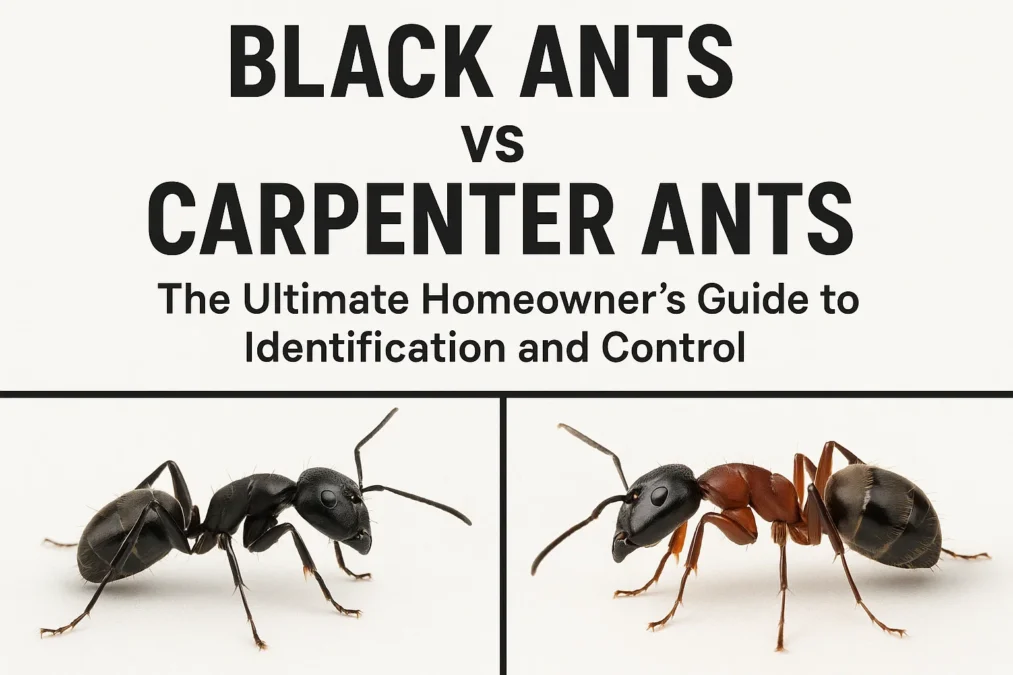You see them marching in a disciplined line across your kitchen counter. A trail of ants has suddenly appeared, and your first thought is a mix of annoyance and dread. But before you grab the nearest spray or call an exterminator, there’s a critical question you need to answer: are you looking at common black ants or the more destructive carpenter ants? This isn’t just academic; it’s the difference between a minor nuisance and a potential threat to your home’s structural integrity. Mistaking one for the other can lead to ineffective treatments and, in the case of carpenter ants, thousands of dollars in hidden damage. This comprehensive guide will arm you with the knowledge to confidently tell black ants vs carpenter ants apart, understand their behaviors, and implement the right strategies to keep your home safe and pest-free. We’ll dive deep into their physical characteristics, habitats, diets, and the unique signs of infestation they leave behind. By the end, you’ll be an expert in ant identification and know exactly what steps to take, whether you’re dealing with a tiny scavenger or a wood-chewing excavator.
Understanding the Basic Differences Between These Two Common Ants
At first glance, to the untrained eye, a black ant is just a black ant. However, the term “black ant” is often a catch-all phrase for many small, dark-colored ant species, most commonly the odorous house ant. When people talk about black ants vs carpenter ants, they are usually comparing these common nuisance ants to the larger, more formidable wood-destroying ones. The fundamental difference lies in their relationship with wood. Common black ants, like odorous house ants, are simply looking for food and water. They build their nests in soil, under stones, or in rotting wood outside, but they do not eat or damage sound wood. They are foragers, invaders of your pantry, but not architects of destruction.
Carpenter ants, on the other hand, have a very different mission. They are one of the largest ant species in North America and are known for their ability to tunnel through wood to create vast, smooth-walled nesting galleries. It’s crucial to understand that carpenter ants do not eat wood; they excavate it. They chew through damp, damaged, or sometimes even sound wood to create elaborate tunnels and chambers for their colonies to live in. This behavior is what makes them a significant pest for homeowners. They push the sawdust-like material, called frass, out of tiny kick-out holes, leaving behind a telltale sign of their presence. So, while a trail of small black ants on your counter might mean you need to clean up spills better, a trail of large black ants could indicate a much more serious, hidden problem within your walls. This core distinction in behavior and purpose is the heart of the black ants vs carpenter ants debate.
A Detailed Look at Physical Appearance and Identification
Telling these ants apart physically is your first and most powerful tool. While both may be dark in color, a closer look reveals several distinct differences in size, shape, and anatomy. It’s like comparing a compact car to a pickup truck; they might both be vehicles, but their build and purpose are vastly different. For a positive identification, try to examine a few worker ants from the trail, as there can be size variations within a single colony. If possible, capture one in a clear container or take a macro photo with your phone for a closer inspection.
When examining a common black ant, such as the odorous house ant, you’ll notice it is relatively small, typically measuring between 1/16th and 1/8th of an inch long. Their bodies are not uniform; they have a distinctly unevenly shaped thorax (the middle body segment) when viewed from the side, and they possess a single node or bump (petiole) between their thorax and abdomen. If you were to crush one—and we don’t necessarily recommend it—it may emit a faint, rotten coconut-like odor, which is how it got its name. In contrast, the carpenter ant worker is a much more imposing insect. They are significantly larger, with major workers often reaching 1/2 inch in length or even more. Their bodies are more robust and uniformly rounded. A key identifier is their thorax, which is evenly rounded when viewed from the side, without the spines or dips common in other ants. They have a single, rounded node between the thorax and abdomen. Their antennae are elbowed, a trait common to all ants, but on a carpenter ant, they are particularly prominent. Color can also be a clue; while many carpenter ants are black, some species can be reddish-orange or a combination of black and red.
Comparison Table: Black Ants vs Carpenter Ants
| Feature | Common Black Ant (e.g., Odorous House Ant) | Carpenter Ant |
|---|---|---|
| Average Size | 1/16 – 1/8 inch | 1/4 – 1/2 inch (major workers) |
| Body Shape | Uneven thorax; small and narrow | Robust, rounded, and uniformly shaped thorax |
| Color | Dark brown to black | Black, red, or a combination (black & red) |
| Node (Petiole) | One, hidden | One, rounded and visible |
| Antennae | Elbowed | Elbowed |
| Waist | Narrow | Narrow |
| Wings (Swarmers) | Front wings longer than hind wings | Front wings longer than hind wings |
| Distinguishing Sign | “Rotten coconut” odor when crushed | Sawdust-like frass near kick-out holes |
Habitat and Nesting Behaviors: Where Do They Live?
The places these two ants call home couldn’t be more different, and understanding their preferred real estate is critical to locating and eliminating them. Common black ants are outdoor dwellers at heart. They prefer to establish their colonies in the soil, often under rocks, logs, piles of bricks, or mulch. They are opportunists, however, and if a crack in your foundation or a gap around a window frame provides easy access to the food and moisture inside your home, they will happily send thousands of foragers indoors. Their indoor nests are usually temporary satellite colonies, not the main headquarters. The primary nest remains outside, meaning your indoor ant problem is often a symptom of an outdoor colony.
Carpenter ants have a much more intimate relationship with your home’s structure. They seek out moist, soft, or previously damaged wood to establish their primary colonies. Common outdoor nesting sites include tree stumps, dead tree limbs, old woodpiles, and wooden landscaping ties. When they move indoors—which they often do—they target areas that have sustained water damage. This includes window and door frames, soffits, roof sheathing, subfloors near leaking plumbing, and areas around poorly sealed bathtubs and showers. Unlike termites, they do not consume the wood for nourishment; they meticulously carve it out to create smooth, clean galleries for raising their young. A mature colony can have a main nest, often in a parent satellite location outside, and several satellite nests inside a home. These satellite nests can be established in perfectly dry wood, making them a pervasive threat. This nesting behavior is the central reason why the black ants vs carpenter ants question is so important; one is a trespasser, the other is a squatter that remodels your house without permission.
Diet and Foraging Patterns: What Are They After?
What these ants are searching for when they enter your home is another major point of differentiation. Their dietary preferences directly influence their behavior and the clues they leave behind. Common black ants are the ultimate sugar addicts. They have a powerful sweet tooth and are primarily attracted to sugary substances. You’ll find them swarming over spilled juice, syrup, honey, soda, and ripe fruit. They are also attracted to other food sources, including greasy materials and proteins, but their primary mission indoors is usually to find sugar. They follow well-established scent trails laid down by scout ants, leading directly from their nest to the food source and back, which is why you see those characteristic orderly lines.
Carpenter ants have a more balanced and complex diet. While they will certainly not turn down a sweet treat—they are known to feed on aphid honeydew (a sugary secretion) outdoors and will go for sugary baits indoors—their primary nutritional needs are met through protein and fats. They forage for other insects, both living and dead, to feed their growing larvae. Inside a home, this might mean they are attracted to pet food, meat scraps, and other protein-rich sources. However, it’s vital to remember that they are not in your home for the food in your kitchen; they are there for the wood that makes up your house. The foragers you see are often workers searching for water and food to bring back to the main colony, which is hidden away in a wall void or other structural element. This difference in diet is crucial for effective control; while sweet baits work well for many common ants, a combination of protein and sugar baits is often most effective for eradicating a carpenter ant colony.
Signs of Infestation: What to Look For in Your Home
Recognizing the evidence left behind by these ants is the key to diagnosing your problem correctly. The signs of a common black ant infestation are straightforward and primarily visual. The most obvious sign is seeing a consistent trail of small, dark ants, particularly in the kitchen or pantry areas, heading toward a food source. You might also find a few scattered scouts wandering around bathrooms or other areas searching for water. Since they often nest outdoors, you might notice small piles of soil or sand near your foundation, which is the excavated material from their nest construction.
The signs of a carpenter ant infestation are more subtle and, if missed, can lead to severe structural damage over time. The most definitive sign is the presence of frass. This is a sawdust-like material that the ants push out of their nests through small slit-like openings called “kick-out holes.” This frass will often accumulate on surfaces below these holes, like baseboards, window sills, or in basements, and may contain insect parts, a byproduct of their diet. Another sign is the sighting of swarmers, or reproductive ants with wings, inside your home. These emerge, usually in the spring, to mate and start new colonies. Finding discarded wings near windowsills is a strong indicator that a mature colony is nearby. You might also hear a faint rustling or crinkling sound coming from within walls or woodwork, which is the sound of the colony moving and communicating. Finally, seeing large, lone forager ants, especially at night (as they are primarily nocturnal), is a major red flag. These signs require immediate investigation, as they point to a potentially serious and established infestation.
The Real Threat: Damage and Health Concerns
When evaluating the risk of black ants vs carpenter ants, the scale of potential harm is dramatically different. Common black ants are considered nuisance pests. They do not pose any structural threat to your home, as they do not chew or damage wood for nesting. From a health perspective, they are more of a contaminant than a direct threat. They can crawl over unclean surfaces and then traverse your food preparation areas, potentially transferring bacteria like Salmonella. While this is a concern, it is generally manageable through good sanitation and eliminating the ants’ access to food.
Carpenter ants, however, represent a genuine threat to the structural integrity of your property. The damage they cause is often compared to termite damage, though it typically progresses more slowly. A single, large colony can weaken critical support beams, floor joists, window headers, and sill plates over several years. The cost of repairing this damage can run into the tens of thousands of dollars if it is left unchecked. The insidious nature of this damage is that it occurs hidden from view, inside walls, attics, and crawlspaces. By the time you notice sagging floors or weakened wood, the infestation is likely severe. While they do not sting and rarely bite (their bites are not venomous but can be pinching), their primary danger is economic and structural. They are a pest that demands immediate and professional attention to prevent costly repairs.
Effective Prevention Strategies for Your Home
An ounce of prevention is truly worth a pound of cure, especially when it comes to pest control. The strategies for preventing these two types of ants overlap in some areas but have specific nuances. For both common black ants and carpenter ants, the first line of defense is eliminating points of entry. This involves sealing cracks and crevices in your home’s exterior foundation, caulking around windows and door frames, and ensuring weather stripping is intact. Repairing leaky faucets, pipes, and faulty drainage is also critical, as all ants are attracted to moisture.
For common black ants, the focus should be on impeccable sanitation. This means wiping down counters daily, storing food—especially sugar, honey, and syrup—in airtight containers, promptly cleaning up spills, and taking out the trash regularly. Managing your outdoor landscape is also key; keep mulch, leaf litter, and vegetation away from your foundation, and store firewood well away from the house and elevated off the ground.
Preventing carpenter ants requires a more vigilant approach to moisture control. Since they are attracted to damp wood, you must proactively address any water issues. Ensure your roof is in good repair, gutters and downspouts are clear and direct water away from the foundation, and your attic and crawlspace are well-ventilated to prevent condensation. Prune tree branches and shrubs so they do not touch your house, as these can provide a convenient bridge for carpenter ants to travel from outdoor nests to your home. Regularly inspect the perimeter of your home for any signs of decaying wood and replace it promptly. By making your home less attractive and accessible, you can significantly reduce the risk of an infestation of either type of ant.
Treatment and Control Methods: DIY vs. Professional Help
Once you’ve identified which ant you’re dealing with, the approach to elimination varies significantly. For common black ants, many homeowners have success with do-it-yourself methods. The most effective DIY approach is often using bait gels or stations. The forager ants take the bait, which is a slow-acting insecticide mixed with an attractive food source, back to the nest and share it, ultimately eliminating the queen and the colony. You can also use non-repellent sprays around the perimeter of your home to create a barrier that ants will cross unknowingly and transfer to others.
Treating a carpenter ant infestation is far more complex and is often a job best left to professional pest control companies. The challenge lies in locating the main nest and any satellite nests, which are usually hidden within walls. DIY surface sprays will only kill the foragers you see, doing nothing to impact the heart of the colony. While there are carpenter ant-specific baits available, their success depends on the ants’ current dietary needs (protein vs. sugar), which can change. Professionals have the training, experience, and tools—such as moisture meters, borescopes, and specialized insecticides—to properly diagnose the extent of the infestation and target the nests directly. They may use dust insecticides that can be puffed into wall voids where nests are located, providing a more thorough and lasting solution. Attempting to handle a carpenter ant problem yourself can lead to prolonged frustration, colony satelliteing, and continued hidden damage. The investment in professional help for a carpenter ant issue is almost always justified.
“Seeing a few large black ants indoors is rarely an isolated incident. It’s usually the warning sign of a much larger, hidden colony that requires immediate attention.” – Entomologist David Price
The Lifecycle and Colony Structure
Understanding how these ants live and reproduce provides insight into why they are so successful and why complete eradication is necessary. Both common black ants and carpenter ants are social insects that live in colonies with a caste system consisting of queens, males, and workers. The lifecycle for both begins with an egg, which hatches into a larva. The larva is fed and cared for by worker ants until it pupates and finally emerges as an adult ant.
A typical common black ant colony is moderate in size, containing one to several queens and thousands of workers. They can also form supercolonies with many interconnected nests. Carpenter ant colonies are much larger and take longer to establish. A mature carpenter ant colony can contain over 10,000 workers, sometimes up to 50,000, and will have one primary egg-laying queen. It can take several years for a colony to reach this size and produce swarmers (winged reproductive ants). This large, complex social structure is why simply killing visible foragers is ineffective; you must eliminate the queen and the brood to stop the colony for good. The reproductive cycle is also why seeing swarmers indoors is such a serious sign—it indicates the colony is mature and trying to expand.
Common Misconceptions and Myths Debunked
There is a lot of misinformation floating around about ants, which can lead to misidentification and failed control attempts. One of the biggest myths in the black ants vs carpenter ants discussion is that “all big black ants are carpenter ants.” While carpenter ants are notably large, other ant species, like the robust pavement ant, can also be dark and sizeable. Always use multiple identification features, not just size. Another common misconception is that carpenter ants eat wood. As we’ve established, they only excavate it; termites are the ones that actually consume cellulose for nutrition.
Many people believe that if they see ants outside their home, they are doomed to have an infestation inside. This is not true. Ants are a natural part of the ecosystem outdoors. The goal is not to create a sterile, ant-free yard—an impossible task—but to make your home an unappealing fortress they cannot enter. Finally, a dangerous myth is that DIY treatments are always sufficient. For a small odorous house ant problem, they might be. For a carpenter ant infestation, professional intervention is almost always necessary to find and destroy the hidden nest and prevent ongoing damage. Relying on store-bought sprays for a carpenter ant issue is like putting a bandage on a deep wound; it might cover the surface, but the problem underneath continues to fester.
When to Call a Professional Exterminator
Knowing when to call for backup is a sign of a savvy homeowner, not admission of defeat. For common black ants, you should consider professional help if your DIY efforts have failed after several weeks, if the infestation is widespread and persistent, or if you simply don’t have the time or desire to deal with it yourself. Pest control professionals can quickly identify the species, locate the nest, and apply long-lasting barrier treatments.
For carpenter ants, the threshold for calling a professional is much lower. You should contact a licensed exterminator immediately if you observe any of the classic signs: frass, swarmers indoors, large foragers inside at night, or any evidence of moisture damage that could attract them. If you even suspect you might have carpenter ants, it is worth the cost of an inspection. A professional can provide a definitive identification, assess the potential for damage, and formulate a targeted treatment plan. This proactive approach can save you immense amounts of money, stress, and structural headache down the road. Don’t gamble with the wood that holds your house together.
“The cost of a professional pest inspection for carpenter ants is negligible compared to the cost of replacing a load-bearing beam they’ve hollowed out over the years.” – Home Inspector Linda Carter
Conclusion
The journey from seeing an ant on your floor to achieving a pest-free home hinges entirely on one critical skill: accurate identification. The difference between black ants vs carpenter ants is the difference between a manageable household annoyance and a serious structural threat. Common black ants, like the odorous house ant, are scavengers in search of a sweet meal. They require a response focused on sanitation, exclusion, and targeted baiting. Carpenter ants are a different beast entirely—silent excavators tunneling through the very wood that supports your home, demanding immediate, professional intervention.
By learning to distinguish their size, shape, and the telltale signs they leave behind, like frass and swarmers, you empower yourself to take the correct action. Remember, prevention is your strongest weapon. By managing moisture, sealing entry points, and maintaining your property, you can defend your home against both of these common invaders. Stay vigilant, trust the evidence, and don’t hesitate to call in the experts when the situation points to the more destructive of these two insects. Your home is your biggest investment; protecting it starts with knowing your enemy.
Silkie Rooster vs Hen: Your Ultimate Guide to Telling Them Apart
Frequently Asked Questions (FAQ)
What is the main difference between black ants and carpenter ants?
The main difference lies in their behavior and impact on your home. Common black ants (like odorous house ants) are nuisance pests that come indoors foraging for food, primarily sweets. They do not cause structural damage. Carpenter ants are larger and excavate moist or damaged wood to build their nests, which can compromise the structural integrity of your home over time. They are a destructive pest, not just a nuisance.
Can carpenter ants be small, or are they always large?
Carpenter ant colonies have a caste system with workers of different sizes. While the major workers are famously large (up to 1/2 inch), the colony also contains medium and minor workers that are smaller. However, even the smaller carpenter ant workers are generally larger than the average common black ant, and they will have the same robust, uniformly rounded body shape.
I only see a few big ants every now and then. Do I have an infestation?
Seeing a few large, lone carpenter ants indoors, especially at night, is a significant warning sign. These are likely scout foragers from a mature colony that is already established somewhere in or around your home. It is rarely just a few ants passing through. This pattern warrants a thorough inspection for other signs like frass or a professional evaluation.
Are the DIY store-bought sprays effective against carpenter ants?
Generally, no. Surface sprays only kill the ants you see—the foragers. They do not reach the hidden queen and brood deep within the nest. This can actually make the problem worse by causing the colony to split and create multiple satellite nests. Effective carpenter ant control requires locating and treating the nest directly, which is extremely difficult without professional tools and expertise.
How quickly can carpenter ants cause damage?
Carpenter ant damage occurs slowly compared to termites. It can take several years for a colony to grow large enough to cause significant structural weakening. However, the longer an infestation is left untreated, the more extensive and costly the damage becomes. A colony that is already producing swarmers (winged reproductive) is mature and has been present for at least three to six years.



